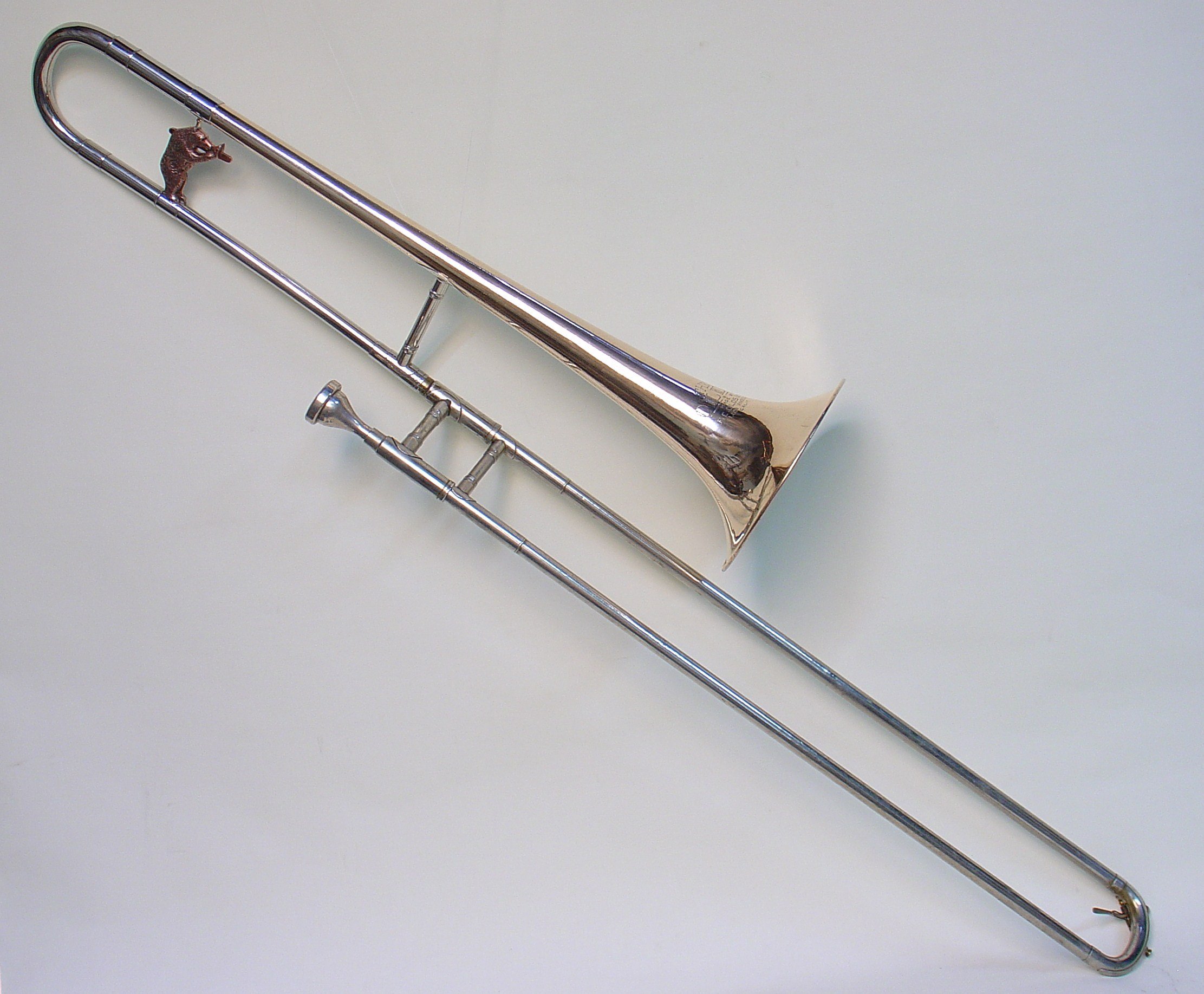Olds Super Trombone Evolution
Olds Super trombones are familiar to anybody who has been around brass instruments for an extended time. They were very popular in their day, which lasted from about 1935 until production ended in 1979. There are probably more than 10,000 of them in existence and you can buy one in very good condition for much less than comparable newer instruments.
Excellent example of Super Olds Trombone from about 1938. This one with “R. B. Olds” engraves on the Tone Band.
They are immediately recognizable by the bell garland or "Tone Band" with the make and model engraved on it. The earlier versions were even nicer with lightweight red brass bells, all other parts nickel silver, the inside slide tubes were fluted to reduce friction and the signature hand engraved on he tone band. The earliest tone bands were 1" wide compared with the later examples at 5/8".
Earliest “tone bands” were 1”, then 5/8”.
What I learned later, after many years of familiarity with this model, is that there was another earlier version of the Olds Super trombone. The next two images show this instrument the way that it was made in about 1935. The catalog that the first image comes from can be dated by the fact that it illustrates the fluted slide tubes as they were in the original patent of November, 1935. In this, the inside slide tubes had grooves rather than the flat sides and probably proved impractical and may have never been in production. The idea was refined and patented again in January, 1938 (applied for Sept. 1936).
Catalog image from about 1935.
The slide section (.485"/.500" bore) is almost identical to the Supers made a few years later including the fluted slide tubes, although with earlier style braces. The dimensions of the bell section appear to be the same aside from a 7" rather than 7 1/2" rim which, in later years, became the only size available. The catalog indicates that 6" to 8" bells and the usual variety of bores were available in this model. It has a very different look in that the tone band is not present and a very unique bell brace/weight is. This is a three dimensional model of the trombone playing bear that had been engraved on the trombone bells since the mid-1920s. Both the bear counter weight and fluted slides are also seen on Standard model trombones from this era, although not illustrated in the catalog. The red brass alloy of the bell flare appears to be the same but has thicker walls, allowing for the typically heavy engraving in the more conventional position. The model name is not indicated in the engraving and so for the years that I have owned it until now, I thought that it was some custom ordered variant of the Standard Self Balancing trombone. The serial numbers are 9822 and 10,019. An earlier example has been reported to me with a serial number below 8400. I would think that there must be a year or more between the production of these two trombones.
Example of earliest version of the Super Trombone, made about 1936.
The next photo is serial number 11,718 and in almost every way typical of early Olds Super trombones with the narrow tone band. It is extremely well preserved and engraved on the tone band, along with the usual lettering and decoration is "R.B. Olds" (for Reginald Birdsall Olds). This is another case where the engraving is the only connection to a specific history. We can safely assume that this trombone belonged to Reg Olds personally, but beyond that we must speculate. Reg was not known to be a trombone player and it seems unlikely that he spent time between tennis, golf and ski trips to practice one.
Reg Olds’ own Super Trombone.
One theory that I came up with is that it was a prototype trombone using the newly patented (1938) braces on the bell and hand slide, but then a Super Olds trombone with earlier serial number (10,393/10,653), a wide tone band and the 1938 braces appeared on Ebay. This is among the earliest Super Olds trombones with the narrow tone band, but not the earliest known.
The last image is yet another extremely rare variation on the theme and is just a little later with a serial number of 13652. This is the largest Super Olds trombone with tone band that I have come across with a 9" bell rim diameter and .500"/.525" slide bore.
Olds large bore Super Trombone with 9” bell.
Trombones of this size had previously been called bass trombones, although by this time, Olds had introduced the Super Olds Bass Trombone with a slide bore of .562 with the choice of one or two rotary valves. It had a 9" yellow brass bell with no tone band and tuning in the slide like the earlier Olds trombones. When supplied with two valves, both were actuated by levers. This is likely the first bass trombone with two valve levers ever available from a major manufacturer. C.G. Conn and other makers offered a second valve to extend the F valve to E, but was actuated by a knob or wheel on the valve which couldn't be turned while playing.
Between 1935 and 1940, Olds obviously saw great importance in developing their newest and most modern trombone line. These were depression years, and yet, they continued to increase production. Likewise, the Super Olds trumpets and cornets were introduced at this time and by 1940, the famous Super Olds Recording Model appeared. Today these are considerably harder to acquire than the trombones and much more expensive.






